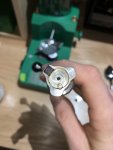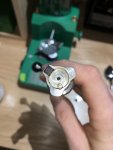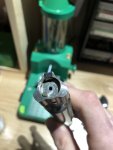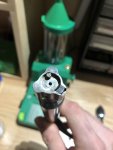If you doubt you’re jamming, that tells me you haven’t actually measured the chamber yet, yes? Do that or buy the tool to do that. It’s important. If you’re on or very close to the lands, id add some jump.
Any chrono data with these?
While primers are shitty for determining pressure, some stuff sticks out in yours. That middle case on the left in the row of three. That primer looks like the load never reached any pressure, there are one or two others in there. That’s a trend in your cases, they run from total creampuff, to pretty good swipes. You could have some spiking pressures. Take some of the cases which show the heaviest pressures, and seat some new primers in them. Primer pockets are the first thing to go in Hornady cases. No need to size the cases, just sacrifice a few new primers in those cases alone.
I agree with the other poster, .1 gr will do nothing as an adjustment, I’d start at .5 at least. You only mentioned accuracy, and nothing about nodes, so you may have not established that yet. If not, I’d sort out the bullet jump question and run a narrow OCW.









